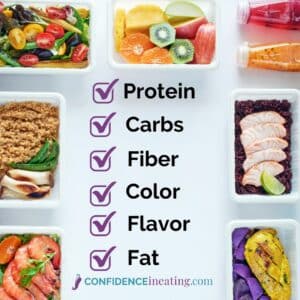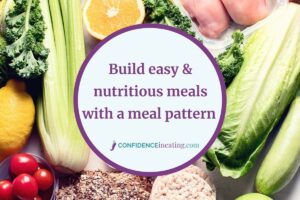Easy healthy meals using a meal pattern for meal planning
Designing a meal pattern with your favorite foods while making healthy food decisions is an effective strategy for making quick and easy meals.
Below is an outline to use in helping assure a variety of nutrient-dense foods are entering your rotation with quick and easy-to-follow tips. We use these meal patterns and talk about them all the time in the Platinum Program.
We used them because using the meal plan patterns helps you to boost your energy and support your mental health, make you more efficient in the kitchen, and improve your time management skills.
You can read more, [Top 5 benefits of meal planning] to understand more about meal patterns.
The key pattern to building quick & easy meals that are simple and nutritious is to use the following formula to help make balanced meals:

By using the 6 meal pattern categories to guide your meal planning, you can make nutritious meals without using too much brain power or energy.
1. Easy meal prep protein meal choices
Start by choosing meal prep easy ideas for your favorite source of protein such as fish, chicken, beef, beans, or eggs. After choosing your source of protein, look for ways to minimize time spent in the kitchen.
Buying a rotisserie chicken to split up for multiple days of the week, or buying frozen cooked proteins are simple ways to save time and simplify recipes. Try batch-cooking beans and freezing them in ready-made portion sizes.
Bulk prepping meal protein sources is an efficient practice. This planning will allow you to cut down on time in the kitchen, providing multiple protein sources for meals to enjoy later.
2. Carbohydrates to maintain energy and focus
Carbs are important when creating a meal, especially if you are on the go and need to maintain energy.
WHY? Here are a few reasons!
Carbohydrates are the body’s preferred source of energy. Carbs are important to maintain healthy functioning organs in our body, especially our muscles, heart, and brain. Without them, you can experience many negative side effects such as low blood sugar, fatigue, hunger, lower thinking ability, and constipation.
Quick sources of carbs for energy can be easy to add. Microwaveable instant rice, pasta, and grains can be your best friend when building quick meals. Even slices of bread, crackers, or tortillas can prove to be a game-changer when on the go.

3. Fiber helps regulate your body
Fiber is found in foods with carbs and adds an important element for nourishing meals that last. The reason fiber is so important is it helps with slowing your digestion of foods and helps the food to satisfy longer, as well as clean your body’s digestive tract.
Fiber is a type of carbohydrate that our body is not able to break down. Although this may sound like a bad thing, this gives fiber some of its many benefits. First, meals high in fiber help us to stay full longer after a meal, without extra calories. This can help control blood sugar as well. In addition, fiber helps our body get rid of waste and keeps our digestive tract healthy.
4. Color for variety and increased meal satisfaction
Adding color for variety and increased meal satisfaction is a winning strategy. Eat the rainbow is the motto to live by.
This rainbow saying can help you to start incorporating a variety of high-fiber fruits and vegetables, which is key to getting the essential daily nutrients our bodies need to stay in tip-top shape.
Eating a variety of foods can also help reduce our tendency to overeat by giving our body the nutrients it needs more regularly. There are no foods with the same nutritional value so eating a wide variety is important.
Microwaveable frozen veggies as well as pre-cut fruits, and veggies are easier and faster. Using less-prep options can be a key point to getting those vitamins and minerals in!
Now that you have the color to enhance satisfaction, the next key group to address is flavor and fats.
5. Fats add texture and flavor to meals
Fats provide a creamy, satisfying mouth feel to dishes and make food taste great. You know this if you have ever tasted the difference between full-fat cheese and non-fat cheese.
Don’t be afraid of using fats in meals. The consumption of fats in moderation helps to produce satisfying meals that stick with you longer. Fat provides a creamy mouthfeel to many dishes.
One way of adding flavor is with fats, but you can also use spices and sauces. Adding sauce can be an effortless way to boost the delicious factor of your meals.
Pre-made pasta sauce, sliced avocado, a light drizzle of olive oil, or even a sprinkle of full-fat shredded cheese can make for a tasty dinner!
You can try incorporating fats throughout the day in your snacks with cheese cubes, yogurts, milk, nuts, and hummus dips. Incorporating healthy fats helps with keeping you full and lowers your chances of getting some diseases. The right balance of fats has also been shown to support cardiovascular and mental health.
6. Flavor enhances the taste of simple foods used in meal planning.
Flavor enhancers come from many sources. Fat is only one way to enhance flavor. You are probably familiar with using salt and pepper to add more flavor to dishes but using a flavor to build a dish may even simplify your strategy.
Instead of the traditional table salt, try freshly grinding salt or pepper to your dish and notice the change. Take a stroll down the spice aisle at your local grocery store and you will see the tremendous variety of choices.
Love Italian dishes? How about grabbing a basil or oregano plant and placing it in your window seal? A freshly picked leaf adds so much depth and freshness to a dish.
Additional flavor tips
- Use natural flavoring from veggies such as garlic, jalapeno, onion, and bell peppers.
- Add herbs such as basil, oregano, lemon pepper, thyme, rosemary, and cilantro.
- Roast vegetables in advance to have handy to top off salads, sandwiches, and grain dishes
Meal planning in action
Knowing how much food you want to make or how many days you want to prepare your food in advance will help you shop efficiently. Making bulk batches of food to eat during the week is always a win.
This advanced planning works well so you can maximize your time and minimize your work.
A meal plan pattern outline could look like some of the following examples:
Pasta night:
- Protein: Shrimp (fully cooked & frozen)
- Carbohydrate: Whole-wheat angel hair pasta
- Fiber: Red pepper & spinach,
- Color: Tomato sauce
- Flavor: & parmesan cheese
- Fat: Olive oil
Chickpea tacos:
- Protein: Chickpeas
- Carbohydrate: Black beans & tortilla
- Fiber: Corn
- Color: Cilantro
- Flavor: Pepper jack cheese, jalapeno
- Fat: sour cream or Greek yogurt
One more meal-planning idea for those meat lovers:
- Protein: Ground beef or ground turkey
- Carbohydrate: Instant brown or white rice
- Fiber: Peppers, Onion
- Color: Corn
- Flavor: Shredded Colby cheese
- Fat: avocado
Use a meal pattern outline to build and customize a meal plan that works best for you. You don’t have to hit every category, just try and get the majority on most meals.
There are many different patterns you can use, I’ve included a couple that I like here


You can get a more in-depth look at timesaving strategies in the kitchen and meals as well as help balance your favorite foods while still working on your health goals by joining the Platinum Program.
If you are unsure if this is the right fit, schedule some time to talk with me on a free discovery call so we can talk about if this is a good program for you.
- If you are not sure how meal planning can help you with this, click here to read the Top 5 benefits of meal planning
- See more information on meal planning about How to plan meals for a week using a meal pattern




